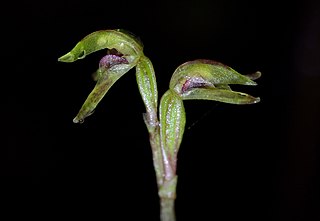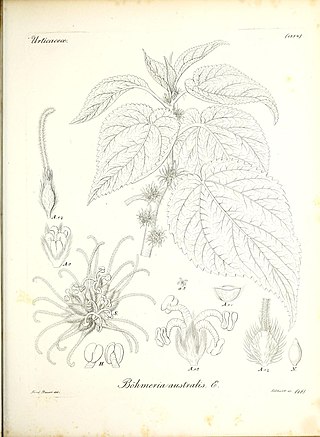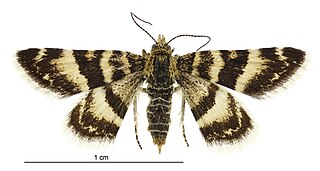
Myosotis is a genus of flowering plants in the family Boraginaceae. The name comes from the Ancient Greek μυοσωτίς "mouse's ear", which the foliage is thought to resemble. In the Northern Hemisphere, they are colloquially known as forget-me-nots or scorpion grasses. Myosotis alpestris is the official flower of Alaska and Dalsland, Sweden. Plants of the genus are not to be confused with Chatham Islands' forget-me-nots, which belong to the related genus Myosotidium.

Coprosma is a genus of flowering plants in the family Rubiaceae. It is found in New Zealand, Hawaiian Islands, Borneo, Java, New Guinea, islands of the Pacific Ocean to Australia and the Juan Fernández Islands.

Cordyline is a genus of about 24 species of woody monocotyledonous flowering plants in family Asparagaceae, subfamily Lomandroideae. The subfamily has previously been treated as a separate family Laxmanniaceae, or Lomandraceae. Other authors have placed the genus in the Agavaceae. Cordyline is native to the western Pacific Ocean region, from New Zealand, eastern Australia, southeastern Asia and Polynesia, with one species found in southeastern South America.

Muehlenbeckia or maidenhair is a genus of flowering plants in the family Polygonaceae. It is native to the borders of the Pacific, including South and North America, Papua New Guinea and Australasia. It has been introduced elsewhere, including Europe. Species vary in their growth habits, many being vines or shrubs. In some environments, rampant species can become weedy and difficult to eradicate.

Olearia, most commonly known as daisy-bush, is a genus of flowering plants belonging to the family Asteraceae, the largest of the flowering plant families in the world. Olearia are found in Australia, New Guinea and New Zealand. The genus includes herbaceous plants, shrubs and small trees. The latter are unusual among the Asteraceae and are called tree daisies in New Zealand. All bear the familiar daisy-like composite flowerheads in white, pink, mauve or purple.

Carmichaelia is a genus of 24 plant species belonging to Fabaceae, the legume family. All but one species are native to New Zealand; the exception, Carmichaelia exsul, is native to Lord Howe Island and presumably dispersed there from New Zealand.

Dracophyllum is a genus of plants belonging to the family Ericaceae, formerly Epacridaceae. There are 61 species in the genus, mostly shrubs, but also cushion plants and trees, found in New Zealand, Australia, Lord Howe Island and New Caledonia. The name Dracophyllum, meaning dragon-leaf, refers to their strong outward similarity to the unrelated Dracaena, sometimes known as dragon tree. Although dicotyledonous, they resemble primitive monocots with their slender leaves concentrated in clumps at the ends of the branches; they are sometimes called grass-trees.

Bulbinella is a genus of plants in the family Asphodelaceae, subfamily Asphodeloideae, first described as a genus in 1843. Many species are endemic to Cape Province in western South Africa, confined to the winter rainfall area. Other species are endemic to New Zealand, where they are most common in the central Otago region which enjoys a similar climate to the Cape Region of South Africa.

Sicyos is a flowering plant genus of the family Cucurbitaceae. Members of the genus may be known as "burr cucumbers", but the genus includes Sicyos edulis which is the christophine or chayote.

Celmisia is a genus of perennial herbs or subshrubs, in the family Asteraceae. Most of the species are endemic to New Zealand; several others are endemic to Australia.

Melicytus is a genus of flowering plants in the family Violaceae. Hymenanthera is a synonym. It includes 19 species native to Australia, New Zealand, and the southwestern Pacific.

Streblus is a genus of flowering plants in the mulberry family, Moraceae. It includes five species native to the Indian subcontinent, Indochina, southern China, and Malesia.

Townsonia, commonly called myrtle beech orchids is a genus of two species of flowering plants from the orchid family, Orchidaceae. They form small clusters of plants with their tubers connected, each tuber with one or two leaves. The flowers are inconspicuous.

Centrolepis pallida is a species of plant of the family Restionaceae. It is found in New Zealand.

Pachycladon is a genus of flowering plants of the family Brassicaceae, native to Tasmania and the South Island of New Zealand. It contains the following species:

Pouzolzia australis, synonyms including Boehmeria australis and Boehmeria calophleba, is a species of large shrub or small tree in the plant family Urticaceae. It is endemic to small islands belonging to Australia and New Zealand – Norfolk Island, Lord Howe Island, and the Kermadec Islands. The population on Norfolk island, sometimes treated as a distinct subspecies, is critically endangered. In the Kermadec Islands, it was described in 2018 as "threatened – nationally endangered".

Notoreas ortholeuca is a species of moth in the family Geometridae. It is endemic to New Zealand.

Lignocarpa is a genus of flowering plants belonging to the family Apiaceae.

Myosotis macrantha or the Bronze Forget-Me-Not is a species of flowering plant in the family Boraginaceae, endemic to the South Island of New Zealand. Joseph Dalton Hooker described the species as Exarrhena macrantha in 1864, and Thomas Cheeseman transferred it to the genus Myosotis in 1885. Plants of this species of forget-me-not are perennial rosettes with ebracteate inflorescences and yellow to dark purple corollas with stamens that are exserted.

Plantago triandra is a species of flowering plant in the family Plantaginaceae that is endemic to New Zealand. Sven Berggren described the species in 1877. Plants of this species of plantain are perennial with a rosette habit, with angular-ovate leaves, tiny calyces, numerous seeds, and often sessile flowers and fruiting capsules. The species is considered to be not threatened.



















